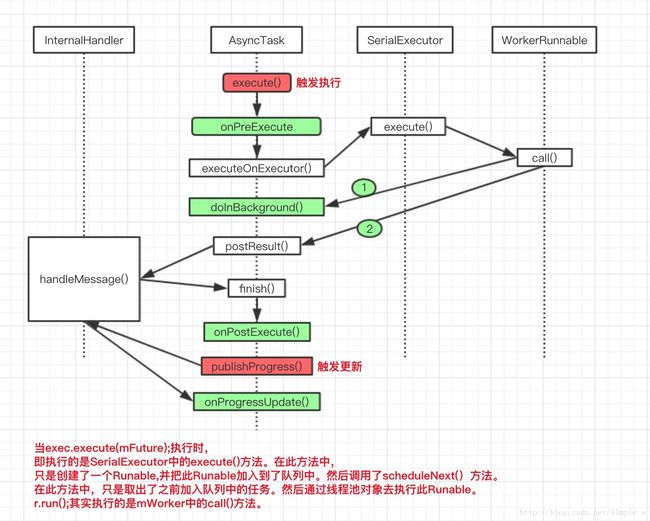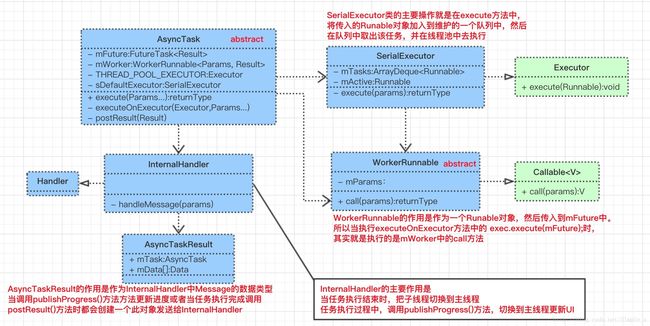AsyncTask源码分析
API版本 26
参考资料:Android开发艺术探索
概述
AsyncTask是底层用线程池和Handler来封装的抽象类。用来执行网络请求等耗时操作。可以创建此类的子类,并重写父类的方法。
AsyncTask的泛型参数
AsyncTask<Params, Progress, Result>Params
其中第一个Params将做事doInBackground方法的参数类型。
Result doInBackground(Params... params);此参数是通过AsyncTask中的execute(Params… params)传递到doInBackground(Params… params)方法中的。可以看出此参数可以传递多个。
Progress
Proress是publishProgress方法的参数类型。用于更新任务的执行进度。
onProgressUpdate(Progress... values)Result
Result是postResult方法的参数类型。此方法的参数是doInBackground方法执行的返回结果。
postResult(Result result)主要的回调方法
onPreExecute
此方法最先执行,在此方法中可以做一些数据的初始化。
doInBackground
此方法运行在主线程中,可以在此方法中做耗时操作。
@Override
protected String doInBackground(String... strings) {
return null;
}onProgressUpdate
此方法运行在主线程中,在任务执行过程中,可以在doInBackground()方法中通过调用publishProgress();来回调此方法做一下进度的更新操作。
onPostExecute
此方法运行在主线程,当doInBackground方法执行结束后,将会回调此方法。可以在此方法中处理任务完成的逻辑。
AsyncTask的简单实用
布局
布局很简单,只是一个按钮,一个进度条。
<LinearLayout xmlns:android="http://schemas.android.com/apk/res/android"
xmlns:tools="http://schemas.android.com/tools"
android:layout_width="match_parent"
android:layout_height="match_parent"
android:orientation="vertical"
tools:context="com.example.yeliang.testapplication.MainActivity">
<Button
android:id="@+id/btn_start"
android:layout_width="wrap_content"
android:layout_height="wrap_content"
android:text="开始下载" />
<ProgressBar
android:id="@+id/pBar_progress"
style="@android:style/Widget.ProgressBar.Horizontal"
android:layout_width="match_parent"
android:layout_height="2dp"
android:max="100" />
LinearLayout>AsyncTask
private class DownLoadAsyncTask extends AsyncTask<String, Integer, String> {
@Override
protected void onPreExecute() {
super.onPreExecute();
progressBar.setProgress(0);
}
//运行在子线程中
@Override
protected String doInBackground(String... strings) {
int progrss = 0;
//模拟每次更新百分之20 更新五次
for (int i = 0; i < 5; i++) {
try {
//模拟耗时
Thread.currentThread().sleep(1000);
progrss += 20;
} catch (InterruptedException e) {
}
//此方法会调用 onProgressUpdate
publishProgress(progrss);
}
return strings[0];
}
@Override
protected void onProgressUpdate(Integer... values) {
super.onProgressUpdate(values);
progressBar.setProgress(values[0]);
}
@Override
protected void onPostExecute(String s) {
super.onPostExecute(s);
Toast.makeText(MainActivity.this, s + "已下载完成", Toast.LENGTH_LONG).show();
}
}Activity
点击按钮使进度条模拟下载。
public class MainActivity extends AppCompatActivity {
//进度条
ProgressBar progressBar;
@Override
protected void onCreate(Bundle savedInstanceState) {
super.onCreate(savedInstanceState);
setContentView(R.layout.activity_main);
Button btn = findViewById(R.id.btn_start);
btn.setOnClickListener(new View.OnClickListener() {
@Override
public void onClick(View v) {
testAsyncTask();
}
});
progressBar = findViewById(R.id.pBar_progress);
}
private void testAsyncTask() {
new DownLoadAsyncTask().execute("downloadUrl---1", "downloadUrl---2");
}
}当创建一个AsyncTask对象时,最终都会调用下面这个构造方法
AsyncTask(@Nullable Looper callbackLooper)
在此方法中,首先会创建一个WorkerRunnable对象mWorker。并用mWorker来创建建FutureTask对象mFuture。
mWorker是一个Callable对象,所以当mFuture作为一个任务执行时,最终执行的是mWorker中的call方法。
public AsyncTask(@Nullable Looper callbackLooper) {
mHandler = callbackLooper == null || callbackLooper == Looper.getMainLooper()
? getMainHandler()
: new Handler(callbackLooper);
mWorker = new WorkerRunnable() {
public Result call() throws Exception {
mTaskInvoked.set(true);
Result result = null;
try {
Process.setThreadPriority(Process.THREAD_PRIORITY_BACKGROUND);
//noinspection unchecked
result = doInBackground(mParams);
Binder.flushPendingCommands();
} catch (Throwable tr) {
mCancelled.set(true);
throw tr;
} finally {
postResult(result);
}
return result;
}
};
mFuture = new FutureTask(mWorker) {
@Override
protected void done() {
try {
postResultIfNotInvoked(get());
} catch (InterruptedException e) {
android.util.Log.w(LOG_TAG, e);
} catch (ExecutionException e) {
throw new RuntimeException("An error occurred while executing doInBackground()",
e.getCause());
} catch (CancellationException e) {
postResultIfNotInvoked(null);
}
}
};
} execute方法是任务开始执行的触发点。在此方法中,调用了executeOnExecutor方法。
execute(Params… params)
@MainThread
public final AsyncTask<Params, Progress, Result> execute(Params... params) {
return executeOnExecutor(sDefaultExecutor, params);
}executeOnExecutor(Executor exec,Params… params)
在此方法中主要做了三件事,如在注释中的说明:
@MainThread
public final AsyncTask executeOnExecutor(Executor exec,
Params... params) {
if (mStatus != Status.PENDING) {
switch (mStatus) {
case RUNNING:
throw new IllegalStateException("Cannot execute task:"
+ " the task is already running.");
case FINISHED:
throw new IllegalStateException("Cannot execute task:"
+ " the task has already been executed "
+ "(a task can be executed only once)");
}
}
//1 把当前的任务状态置为正在运行
mStatus = Status.RUNNING;
//2 回调onPreExecute方法给用户
onPreExecute();
mWorker.mParams = params;
//3 执行在构造方法中创建的任务
exec.execute(mFuture);
return this;
} 可以看到最终把任务的执行转交给了通过SerialExecutor。SerialExecutor的源码如下
SerialExecutor
SerialExecutor中维护了一个任务队列mTasks,当调用execute方法执行任务时,首先创建了一个任务并添加到mTasks中。然后调用scheduleNext()方法。在scheduleNext中直接通过线程池对象执行任务。
需要注意的是,SerialExecutor中的execute方法只是把将要执行的任务添加到任务队列中,而真正的执行是在scheduleNext方法中,通过线程池的对象去执行。
通过前面的AsyncTask中的executeOnExecutor方法的这一句
exec.execute(mFuture);可知,此处的execute方法的参数即为mFuture。而在前面说过mFuture是以mWorker来创建的。所以当线程池开始执行时,执行的是mWorker中的call方法。
private static class SerialExecutor implements Executor {
final ArrayDeque mTasks = new ArrayDeque();
Runnable mActive;
public synchronized void execute(final Runnable r) {
mTasks.offer(new Runnable() {
public void run() {
try {
r.run();
} finally {
scheduleNext();
}
}
});
if (mActive == null) {
scheduleNext();
}
}
protected synchronized void scheduleNext() {
if ((mActive = mTasks.poll()) != null) {
THREAD_POOL_EXECUTOR.execute(mActive);
}
}
} WorkerRunnable
下面来看WorkerRunnable中的call方法。由于call方法是在线程池中执行的。所以此方法运行在子线程。在call方法中调用了doInBackground方法。所以doInBackground同样也是运行在子线程。
最后当doInBackground()方法执行完成后,调用postResult()方法。
public Result call() throws Exception {
mTaskInvoked.set(true);
Result result = null;
try {
Process.setThreadPriority(Process.THREAD_PRIORITY_BACKGROUND);
//noinspection unchecked
result = doInBackground(mParams);
Binder.flushPendingCommands();
} catch (Throwable tr) {
mCancelled.set(true);
throw tr;
} finally {
postResult(result);
}
return result;
}postResult(Result result)
在postResult方法中,只是通过Handler发送了一个消息。并把doInBackground方法中执行的结果对象作为Message的参数传递到Handler中
private Result postResult(Result result) {
@SuppressWarnings("unchecked")
Message message = getHandler().obtainMessage(MESSAGE_POST_RESULT,
new AsyncTaskResult(this, result));
message.sendToTarget();
return result;
} InternalHandler
InternalHandler在此处的作用是把子线程执行的结果切换到主线程中。可以看到当消息类型为MESSAGE_POST_RESULT时,调用了
AsyncTask的finish()方法。
private static class InternalHandler extends Handler {
public InternalHandler(Looper looper) {
super(looper);
}
@SuppressWarnings({"unchecked", "RawUseOfParameterizedType"})
@Override
public void handleMessage(Message msg) {
AsyncTaskResult result = (AsyncTaskResult) msg.obj;
switch (msg.what) {
case MESSAGE_POST_RESULT:
// There is only one result
result.mTask.finish(result.mData[0]);
break;
case MESSAGE_POST_PROGRESS:
result.mTask.onProgressUpdate(result.mData);
break;
}
}
}finish(Result result)
在finish()方法中,首先会调用onPostExecute()方法。然后把当前你的任务状态置为完成。至此任务的执行过程结束。
private void finish(Result result) {
if (isCancelled()) {
onCancelled(result);
} else {
onPostExecute(result);
}
mStatus = Status.FINISHED;
}当任务正在执行时,可以调用publishProgress方法来更新任务的进度。
而因为任务执行在子线程,所以将会通过InternalHandler切换到主线程。
publishProgress(Progress… values)
@WorkerThread
protected final void publishProgress(Progress... values) {
if (!isCancelled()) {
getHandler().obtainMessage(MESSAGE_POST_PROGRESS,
new AsyncTaskResult根据上面这一段可知,此方法只是通过InternalHandler发送了一个消息。
而在的handleMessage()方法中:
case MESSAGE_POST_PROGRESS:
result.mTask.onProgressUpdate(result.mData);
break;把更新操作直接转交给了onProgressUpdate()方法。至此,AsyncTask中的介个回调方法都涉及到了。


